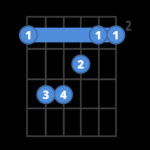Guitar tablature, or “guitar tabs,” is a revolutionary system for writing down music that allows anyone, especially beginners, to quickly pick up and play their favorite songs on the guitar. Think of guitar tabs as a simplified roadmap for guitar music, sharing some similarities with traditional music notation but offering a much more accessible entry point. While standard notation shows musical notes abstractly, guitar tabs show you exactly where to place your fingers on the fretboard.
This direct approach is incredibly beneficial, as guitarists know there are often multiple places on the neck to play the same note. This is why understanding guitar tablature and learning how to read Guitar Music Tabs is such a powerful tool, particularly for those just starting their guitar journey. It opens the door to playing music without the initial hurdle of learning to read traditional sheet music.
At guitarplayers.net, we believe in empowering aspiring musicians with the most effective learning tools. That’s why we introduce students to how to read guitar music tabs early on. Guitar tabs efficiently represent both chords and single notes, making them the quickest route to learning songs you love. The beauty of guitar tabs lies in their simplicity: no prior musical knowledge is needed beyond understanding the strings and frets on your guitar.
If you’re eager to discover what guitar tabs are, what they unlock for your playing, and how to use them, you’ve come to the right place. Let’s dive in and explore the world of guitar music tabs!
WHAT EXACTLY ARE GUITAR MUSIC TABS?
Guitar tablature is a visual representation of music specifically designed for guitar. A standard guitar tab is composed of six horizontal lines, each representing one of the six strings on a guitar. When you learn how to read guitar tabs, you read them from top to bottom. The topmost line corresponds to the high E string (the thinnest string), followed by lines representing the B, G, D, A, and low E strings (the thickest string).
This arrangement mirrors how you see the strings when you look down at your guitar in playing position. Therefore, think of guitar tablature as your personal guide, providing the most direct path to playing guitar songs.
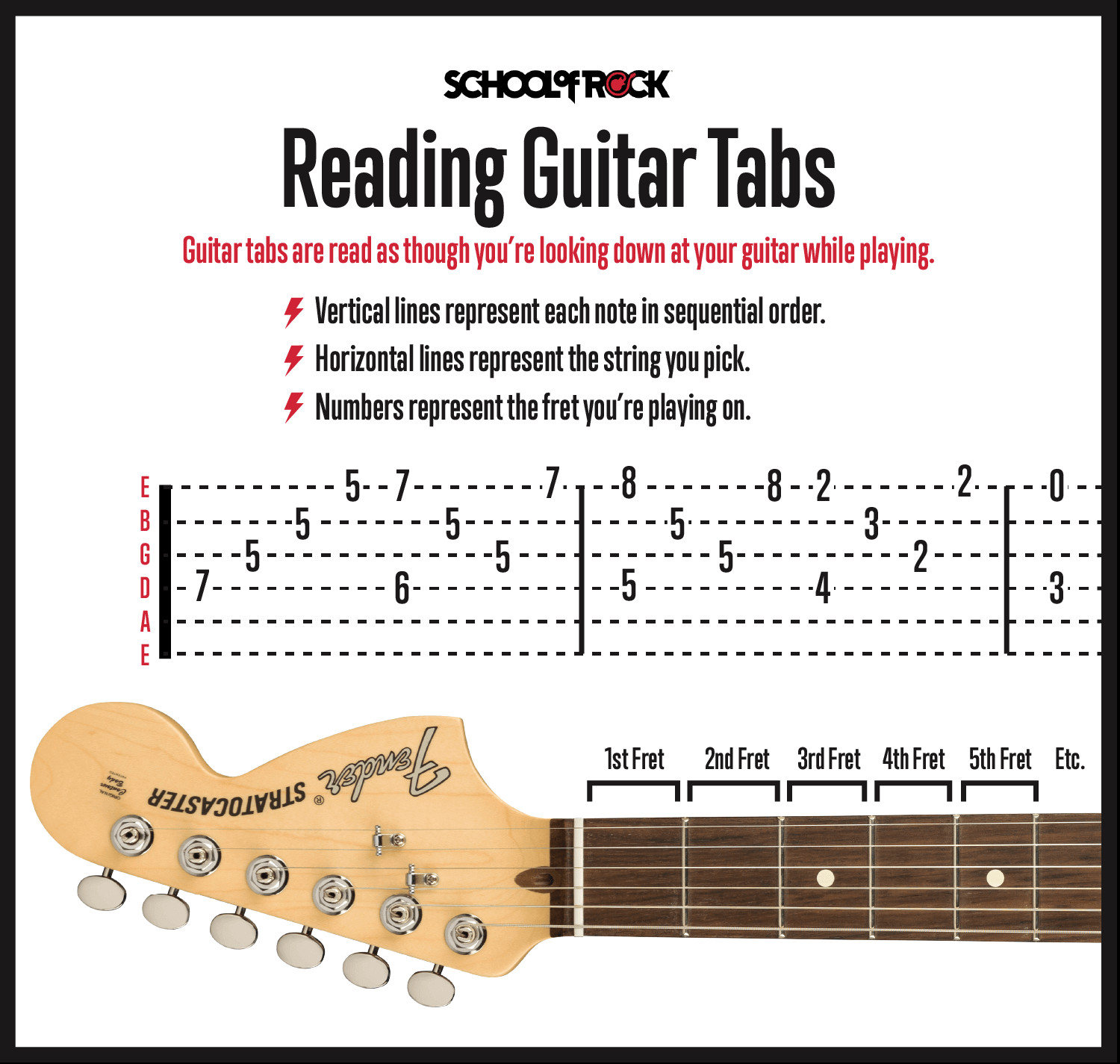 Reading guitar tabs
Reading guitar tabs
As you read guitar tablature, you’ll notice numbers placed on these lines. These numbers indicate the fret you need to use on the corresponding string. Frets are the metal bars along your guitar’s fretboard, numbered 0-24, starting from the nut (closest to the headstock) down the neck.
A “0” on a string means you play that string “open,” without pressing down on any fret with your fretting hand. A “1” signifies playing at the first fret, “2” at the second fret, and so on. When mastering how to read guitar music tabs, remember that these numbers directly translate to fret positions: 1 is the first fret, 2 is the second, 3 is the third, and so on up the guitar neck.
 Play Button
Play Button
STEP-BY-STEP GUIDE: HOW TO READ GUITAR TABS
Guitar tablature is read from left to right, just like standard written language. The notes are presented in the order they are played in the song. When you see numbers stacked vertically on top of each other across multiple lines, this indicates a chord. A chord is played by strumming all the strings indicated at the same time. Guitar tab notation is often considered more beginner-friendly than standard musical notation because it directly shows you which notes to play to form a chord and, crucially, where to play them on your guitar.
ESSENTIAL KNOWLEDGE FOR READING GUITAR TABS
For beginners to successfully learn how to read guitar music tabs, familiarity with the six guitar strings and the location of the frets is key. This basic understanding allows you to translate the tab information into physical actions on the guitar, finding the correct notes to play using the tab as your guide.
DECODING THE GUITAR TAB STAFF
The guitar tab staff visually resembles the staff used in traditional music notation. However, a critical difference is that the lines in a guitar tab represent the 6 guitar strings, not musical pitches.
As mentioned earlier, the top line is the high E string, and the bottom line is the low E string. This direct string-to-line correspondence is what makes playing and learning how to read guitar tabs straightforward for beginners. Typically, a tab staff will also be clearly labeled “TAB” to avoid confusion with standard notation.
UNDERSTANDING GUITAR FRETS IN TABS
Guitar frets, the metal strips spanning the fretboard, are the foundation of note placement in guitar tabs.
Most guitars have between 19 and 24 frets. Each fret represents a single note or a half step (also known as a semitone) in musical pitch. Within each octave, there are 12 notes (or frets). To help navigate the fretboard, guitars usually have fret markers—inlays or dots—on the side of the neck or directly on the fretboard itself. These markers are commonly found at the 3rd, 5th, 7th, 9th, and 12th frets and serve as visual landmarks for quick fret position recognition during playing.
Remember that in guitar tabs, numbers represent fretted strings, while the number “0” indicates an open string. Playing an open string means you pluck or pick the string without pressing down on any fret, allowing it to ring freely.
READING GUITAR TAB CHORDS EFFECTIVELY
Guitar chords, while not having special symbols in guitar tabs themselves, are easily identified by their vertical arrangement. When multiple numbers are aligned vertically in a tab, they are played simultaneously, forming a chord. If a chord is arpeggiated—meaning the notes of the chord are played one after another rather than all at once—it will appear in the tab as a sequence of single notes, even though you are still technically fretting a chord shape.
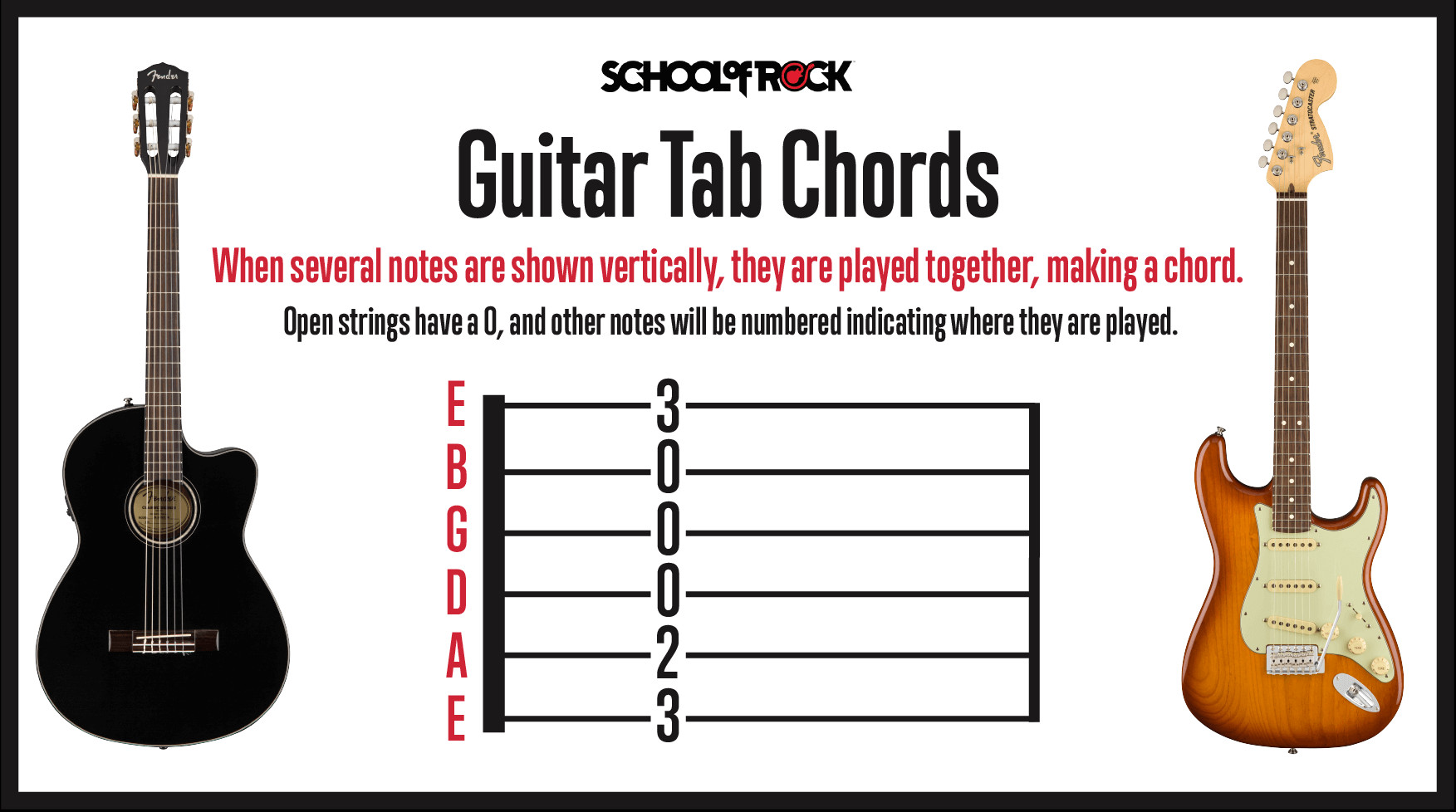 How to read guitar tab chords
How to read guitar tab chords
DECIPHERING GUITAR TAB RIFFS
Many rock, blues, and popular songs are built upon “riffs.” Riffs are typically short, repeated musical phrases that combine single notes and partial chords, such as power chords. When reading guitar tabs for riffs, the same basic rule applies: if two or more notes are vertically aligned, play them together at the same moment. This consistent approach makes learning how to read guitar tablature and play riffs relatively quick and intuitive.
GUITAR TABS VS. CHORD CHARTS: KEY DIFFERENCES
Guitar tabs and chord charts are both tools for guitarists, but they serve different purposes and present information in distinct ways. A chord chart is a diagram that visually shows you where to place your fingers on the fretboard to form a specific chord. It often includes finger numbers to guide you on which finger to use for each string. Chord charts are frequently included above the lyrics of songs to indicate chord changes as you sing or play along.
However, chord charts typically only display the essential 3 or 4 notes that constitute a basic chord. A full and accurate guitar arrangement might include single notes, passing notes (notes outside the basic chord), or arpeggios (playing individual notes of a chord in sequence) that are not shown on a simple chord chart. For this reason, guitar tabs are often used in conjunction with chord charts, especially for beginner guitarists. Tabs provide the detailed musical information needed to play a song accurately, while chord charts can offer a quick reference for basic chord shapes and changes, helping beginners transition from simple chords to more nuanced playing.
UNDERSTANDING FINGER NUMBERS IN CHORD CHARTS
Chord charts, unlike guitar tabs, often incorporate a numbering system to indicate which fingers of your fretting hand should be used to play each note of the chord. The fingers of the fretting hand (the hand that presses down the strings on the fretboard) are assigned numbers: index finger is 1, middle finger is 2, ring finger is 3, and pinky finger is 4.
Guitar tabs, on the other hand, use numbers to represent frets, not fingers. This is why chord charts can be a valuable addition to easy guitar tabs, particularly for beginners. They visually guide hand positioning, complementing the fret-based information in tabs.
PLAY GUITAR IN REAL PERFORMANCES ON STAGE
Our expert-led music programs are designed to equip you with the skills and experience you need to truly play. Step onto the stage and develop your guitar prowess in a supportive, performance-focused environment suited for all skill levels.
GUITAR TAB SYMBOLS: BEYOND NUMBERS AND LINES
Beyond the basic lines and fret numbers, guitar tabs use a variety of symbols to indicate specific playing techniques. Learning to recognize and apply these guitar tab symbols is crucial for making your playing sound authentic and for fully understanding the nuances of guitar music tabs.
Before you start playing any tab, it’s always essential to check your guitar tuning. Playing with correct tuning is fundamental for your guitar to sound right and for your practice to be effective.
MASTERING MUTING GUITAR NOTES
Muting is a fundamental guitar technique, especially in genres like rock, metal, punk, and alternative music. Different muting techniques are used to create specific rhythmic feels and tonal characteristics.
HOW TO EXECUTE GUITAR NOTE MUTING
Muting can be achieved with either your picking hand, your fretting hand, or a combination of both. Primarily executed by the picking hand, muting adds dynamic variation to your playing and is a key element in achieving a polished sound. Many songs utilize muting in verses to create contrast with open, unmuted sounds in choruses or hooks.
Experienced guitarists often employ muting techniques instinctively, even without consciously thinking about it. Especially when playing at amplified volumes, muting is essential for preventing unwanted noise and feedback.
GUITAR TECHNIQUE: PALM MUTING EXPLAINED
Palm muting is one of the most prevalent techniques in rock guitar and many other genres. It’s performed by lightly resting the palm of your picking hand on the strings near the bridge as you pick. Applying heavier palm muting produces a tight, percussive, rhythmic sound, while lighter palm muting allows the notes to ring out slightly more while still being dampened. In guitar music tabs, palm muting is typically indicated by the abbreviation “P.M.” placed above the section of the tab where palm muting should be applied.
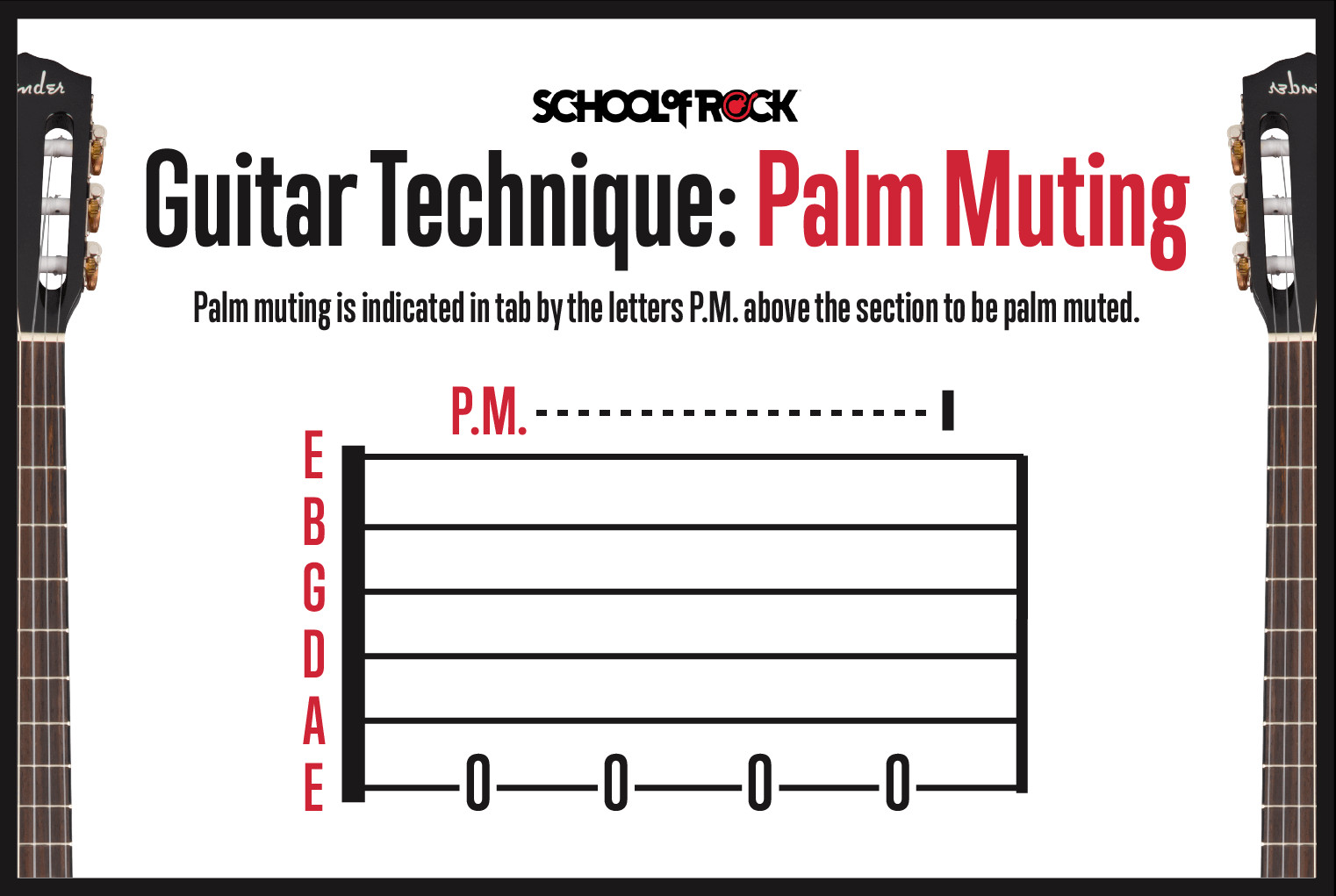 Guitar technique palm muting
Guitar technique palm muting
GUITAR TECHNIQUE: MUTED NOTES (FRET-HAND MUTING)
Muted notes, distinct from palm muting, are created using your fretting hand. In guitar tabs, these are represented by an “X” in place of a fret number. While the note is still picked, your fretting hand lightly touches the strings without fully pressing down on the fretboard. This creates a percussive, muted sound rather than a clear, ringing tone.
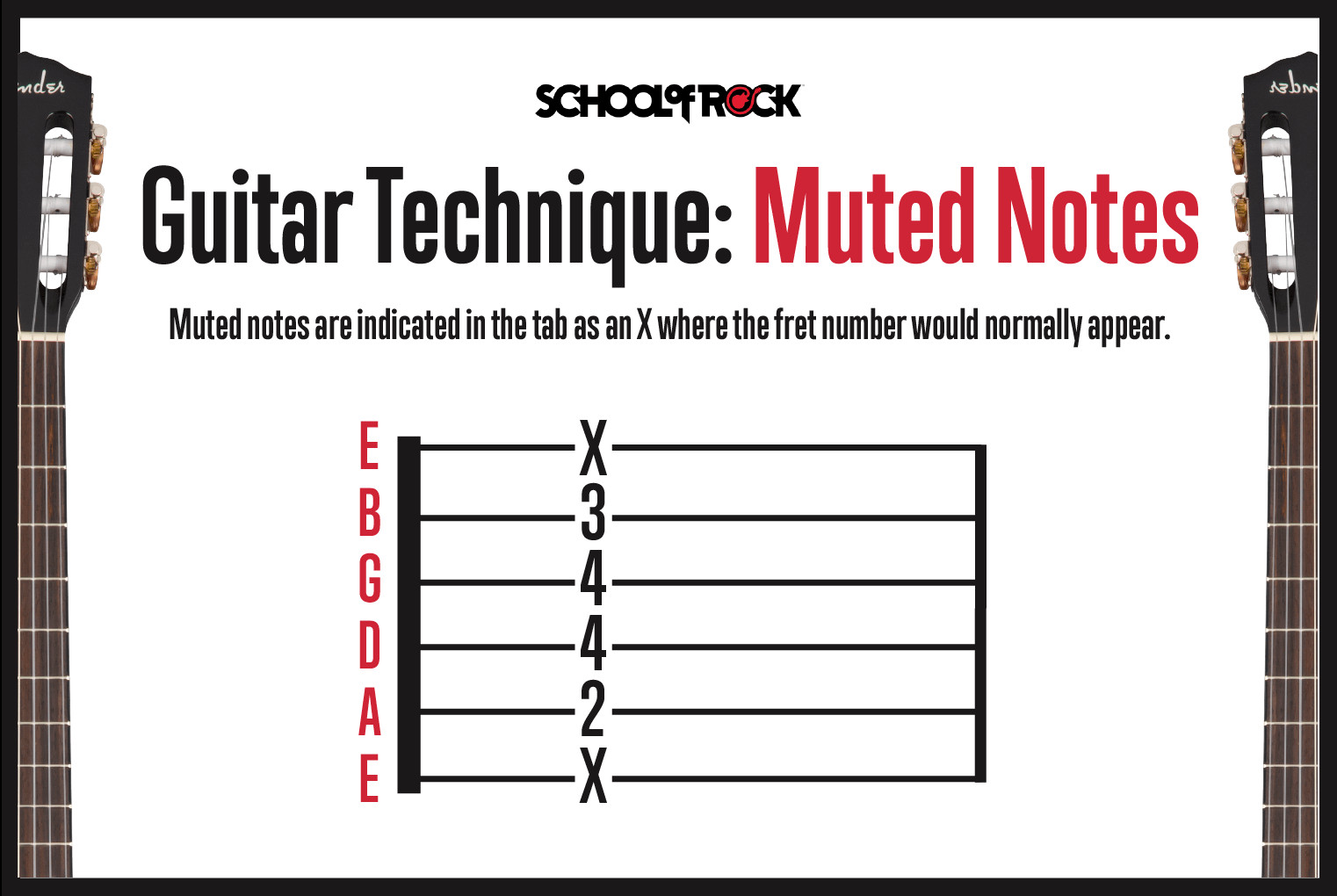 Guitar technique muted notes
Guitar technique muted notes
BENDING GUITAR STRINGS FOR EXPRESSION
String bending is a technique that adds a highly expressive, vocal-like quality to guitar playing. In guitar tabs, bends are usually indicated by a curved arrow above the note to be bent. This arrow signals that you need to increase the pitch of the string. The arrow may also specify the extent of the bend, such as “½” for a half step (one fret) bend or “full” for a full step (two frets) bend. The target pitch of the bend is often referred to as the “target note.”
HOW TO BEND GUITAR STRINGS EFFECTIVELY
Bending is achieved by pushing or pulling the string sideways across the fretboard, rather than pressing straight down as you normally would. For most strings (except the low E), you typically push the string upwards, towards the ceiling. The low E string is usually bent downwards, towards the floor. The key to a good bend is applying smooth, consistent pressure as you bend the string to reach the desired pitch.
GUITAR TECHNIQUE: PERFECTING STRING BENDING
Most string bends are executed using multiple fingers for added strength and control. Typically, you’ll use your “main” fretting finger (often the ring finger) to perform the bend, while the middle and index fingers provide support and reinforcement. This multi-finger approach makes bending smoother, easier to control, and helps achieve accurate pitch.
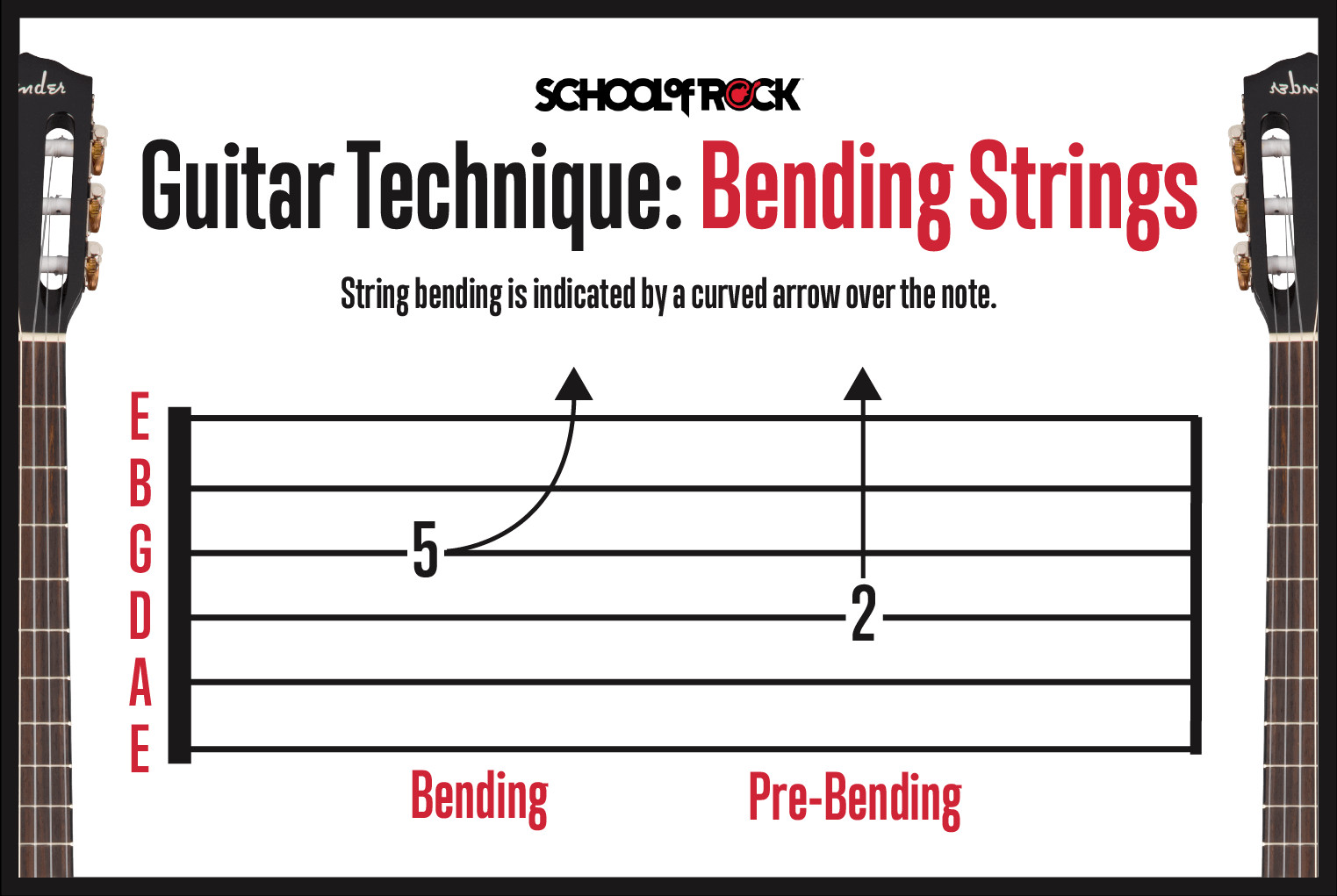 Guitar technique bending strings
Guitar technique bending strings
GUITAR TECHNIQUE: PRE-BENDING GUITAR STRINGS
When learning how to read guitar tabs, beginners might encounter “pre-bends.” A pre-bend involves bending the string before picking it. The tab notation for a pre-bend usually includes an arrow pointing straight up, indicating the bend amount (e.g., “full,” “½”), followed by a curved arrow pointing downwards. After picking the pre-bent string, you might release the bend, letting the string return to its original pitch, or continue the bend further to reach another target note.
SLIDING GUITAR NOTES SMOOTHLY
Sliding is another essential guitar technique that allows you to smoothly transition between notes. You can slide upwards to a higher note or downwards to a lower note. Unlike bending, sliding involves moving your fretting finger along the fretboard to the next desired fret.
GUITAR TECHNIQUE: SLIDE UP NOTATION
In guitar tabs, a slide up to a higher note is represented by a slanted line connecting the starting note to the ending note. The line usually slants upwards slightly to visually indicate an upward slide.
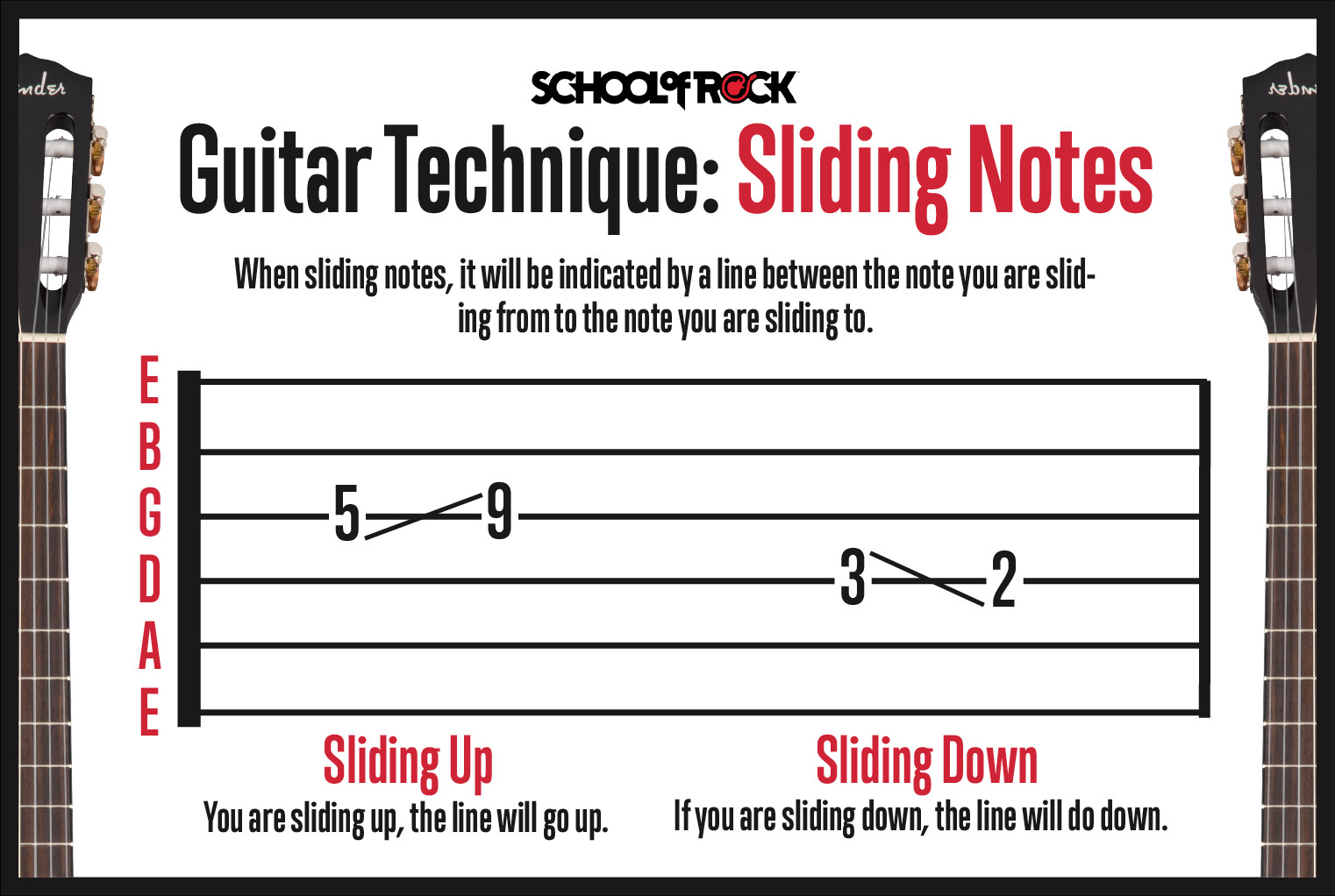 Guitar technique sliding notes
Guitar technique sliding notes
GUITAR TECHNIQUE: SLIDE DOWN NOTATION
Conversely, a slide down to a lower note is also shown by a line connecting the starting and ending notes, but this line will slant downwards slightly to visually represent a downward slide.
PLAYING HAMMER-ONS ON THE GUITAR
The hammer-on is a cool guitar technique where you create a note without picking the string again. Instead, you “hammer-on” to the fretboard with your fretting finger. You can hammer-on from an open string or from a previously fretted note, and the resulting note will always be higher in pitch. In guitar tabs, hammer-ons are indicated by the letter “H” and a curved arc connecting either an open string to the hammered-on note or a fretted note to the hammered-on note.
HOW TO PERFORM GUITAR HAMMER-ONS
To play a hammer-on, strike the guitar string onto the fretboard with your fretting finger with enough force to produce a clear note. This technique requires practice to get a strong, clean sound. Hammer-ons are often easier to execute on electric guitars, especially at higher volumes. A good starting exercise is to play an open low E string and then hammer-on to the third fret with your finger, letting the note ring. Repeat this on different strings and at different frets to build your hammer-on technique.
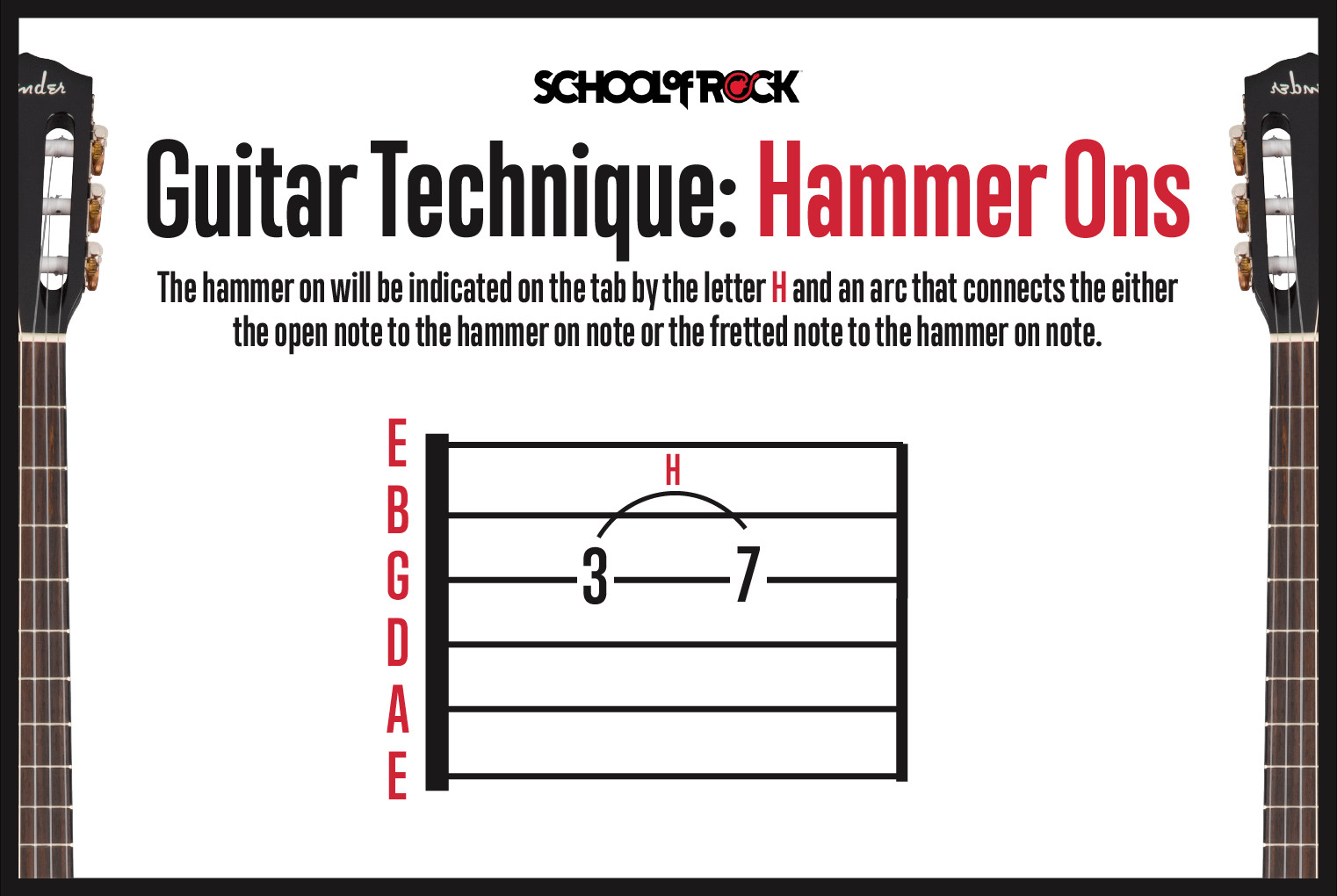 Guitar technique hammer ons
Guitar technique hammer ons
PLAYING PULL-OFFS ON THE GUITAR
Pull-offs are the opposite of hammer-ons. Instead of hammering onto a string, you “pull-off” a fretted note to sound either an open string or a lower fretted note. In guitar tabs, pull-offs are represented by the letter “P” and a curved arc connecting the pulled-off note to the resulting open or fretted note. The resulting note will always be lower in pitch.
HOW TO PERFORM GUITAR PULL-OFFS
To execute a pull-off, you start by fretting a note, then pull your fretting finger off the string in a way that plucks the string and causes it to vibrate. This action sounds either an open string (if you pull off completely) or a lower note that you are fretting with another finger. When performing pull-offs, ensure you “grab” enough of the string with your fingertip as you pull off to make the note sound clearly.
Hammer-ons and pull-offs can be combined in alternating sequences, creating a fluid and fast technique often referred to as a “trill.”
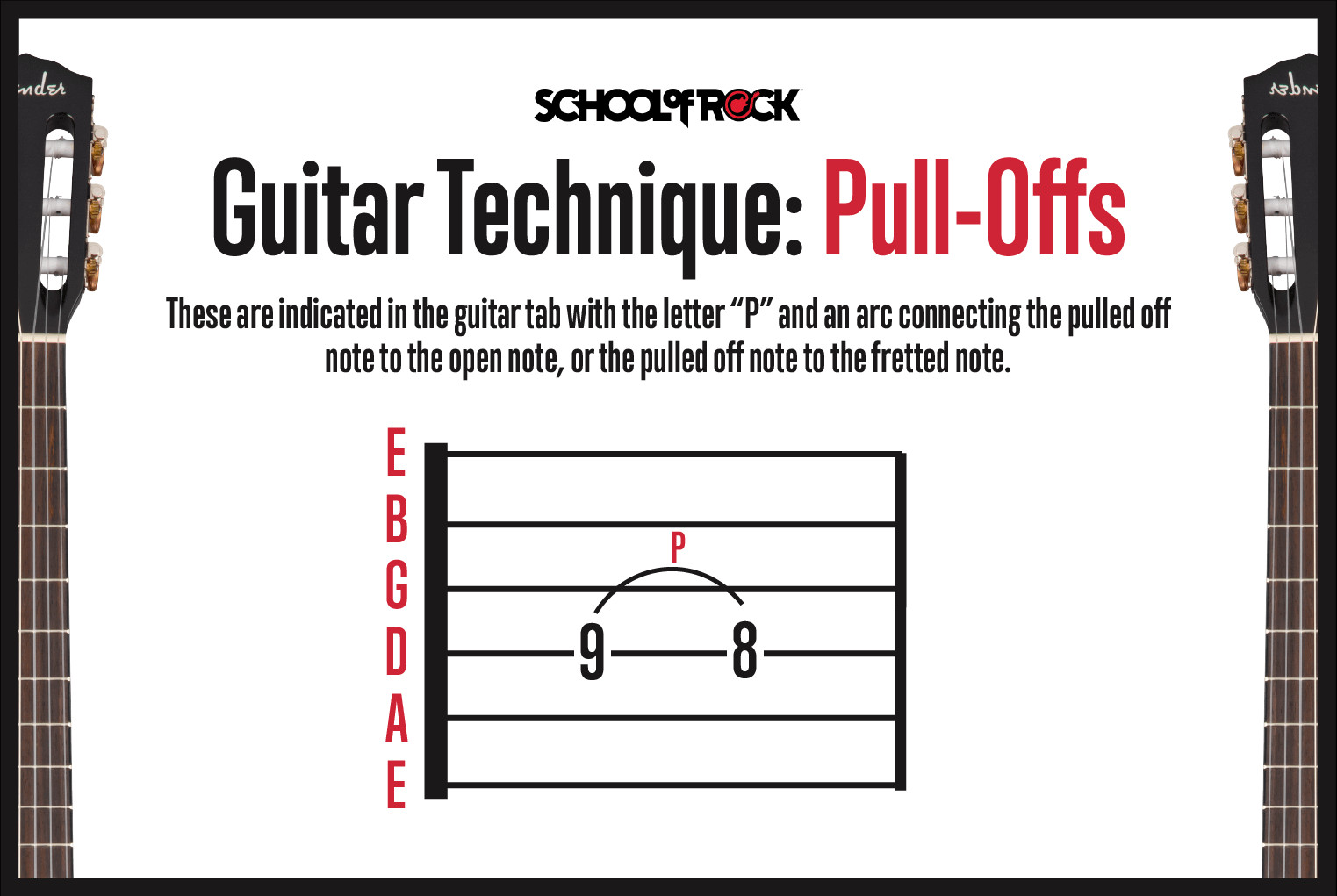 Guitar technique pull offs
Guitar technique pull offs
ADDING EXPRESSION WITH GUITAR VIBRATO
Vibrato is a technique that adds warmth and expressiveness to sustained notes. It involves repeatedly and subtly bending a note up and down in pitch without fully releasing the fretted note. In guitar tabs, vibrato is shown as a zig-zag line drawn above the staff over the note that should have vibrato applied. When learning how to read guitar tablature and vibrato symbols, pay attention to the length of the zig-zag line. Generally, a longer line indicates a longer duration of vibrato.
HOW TO EXECUTE GUITAR VIBRATO
Vibrato is similar to bending, but the pitch variation is much smaller and more rapid. You can apply vibrato using a single finger or by using your main fretting finger supported by other fingers. Start by practicing a slow, smooth vibrato and then gradually vary the speed for different expressive effects. Like bending, vibrato adds a vocal-like quality to guitar solos, and every guitarist’s vibrato is unique, making it a personal and identifiable aspect of their playing style.
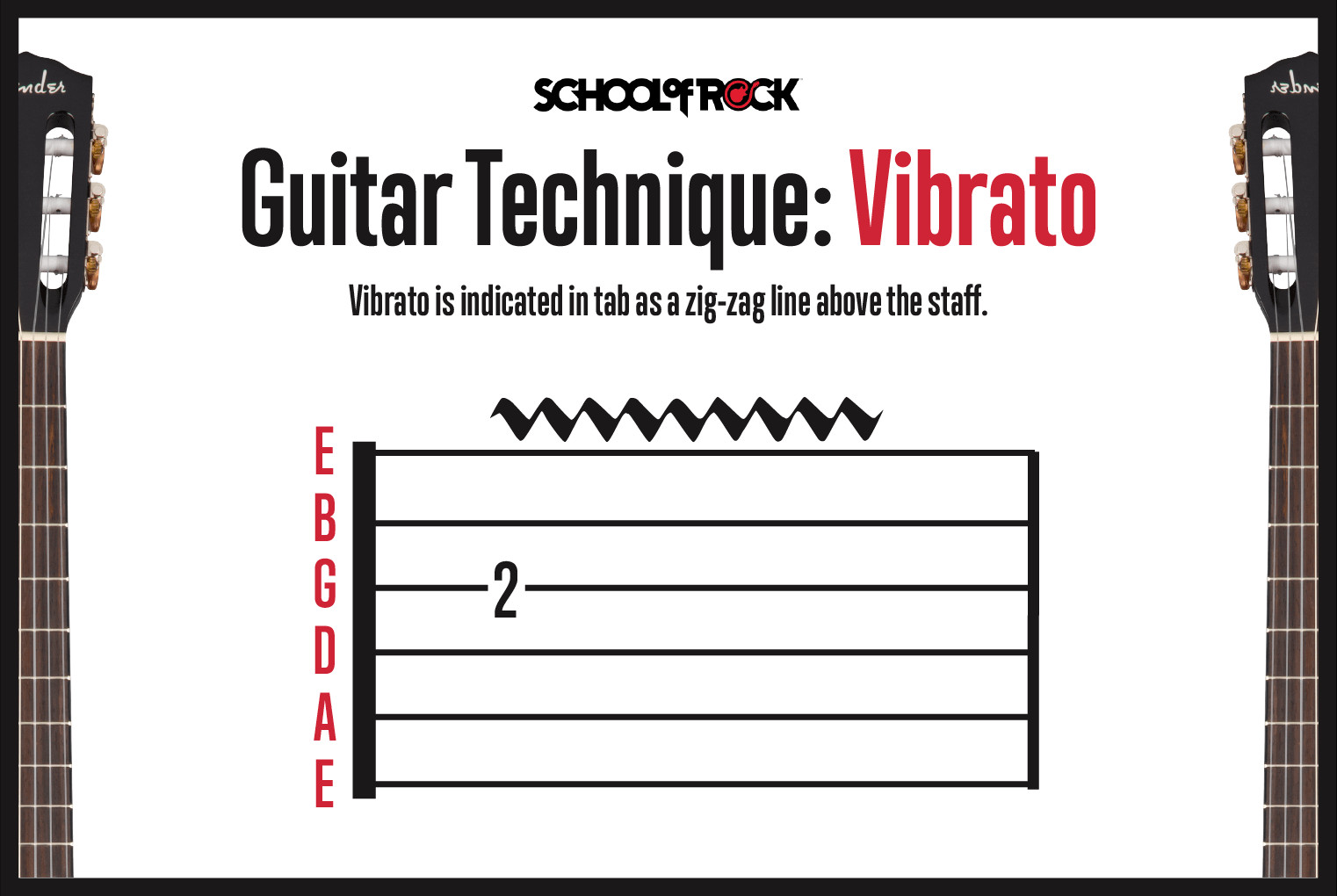 Guitar technique vibrato
Guitar technique vibrato
TAPPING GUITAR TECHNIQUES
Tapping is an advanced guitar technique where you fret notes with your regular fretting hand and also “tap” notes on the fretboard using a finger from your picking hand. The tapping action from your picking hand is essentially a variation of a hammer-on. In guitar tabs, tapping is notated by the letter “T” placed above the tapped note.
HOW TO FINGER TAP ON GUITAR
Tapping was popularized by guitar virtuoso Eddie Van Halen, though the technique has roots in classical guitar. To finger tap, fret a note with your regular fretting hand and then use a finger from your picking hand (typically the index finger) to sharply tap a higher fret on the same string.
Finger tapping expands your playing range as it allows you to play notes with wider intervals than you could reach using only your fretting hand. It also facilitates very fast playing since you are effectively using both hands to fret notes. Playing with overdrive or distortion and at a good volume level often enhances the clarity and impact of tapped notes.
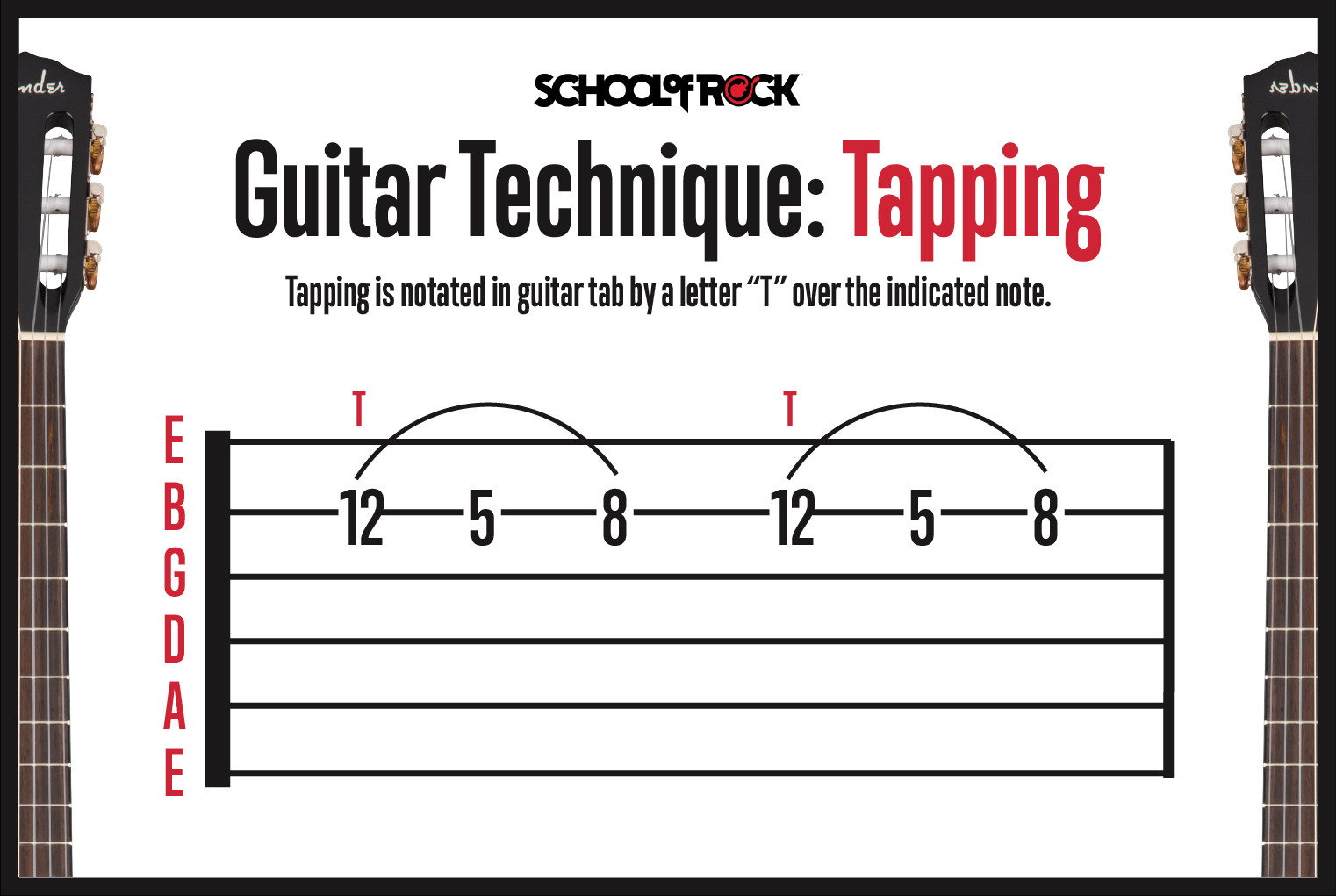 Guitar technique tapping notes
Guitar technique tapping notes
GUITAR TECHNIQUE: TWO-HANDED TAPPING
Two-handed tapping takes the concept further. It’s a technique where both your fretting and picking hands independently tap notes without traditional picking. Often, the fretting hand taps bass notes while the picking hand taps melody or solo lines, creating complex and layered textures.
STRUMMING GUITAR CHORDS AND NOTES
When strumming chords on your guitar, you primarily use two types of strumming motions: downstrokes and upstrokes.
Downstrokes are played from the lower strings towards the higher strings using a downward motion of your pick or strumming hand. In guitar tabs, downstrokes are represented by a symbol that looks like a thick horizontal line with two short “legs” pointing downwards on either side.
Upstrokes are the opposite, played from the higher strings to the lower strings with an upward motion. In guitar tablature, upstrokes are notated by a “V” shaped symbol.
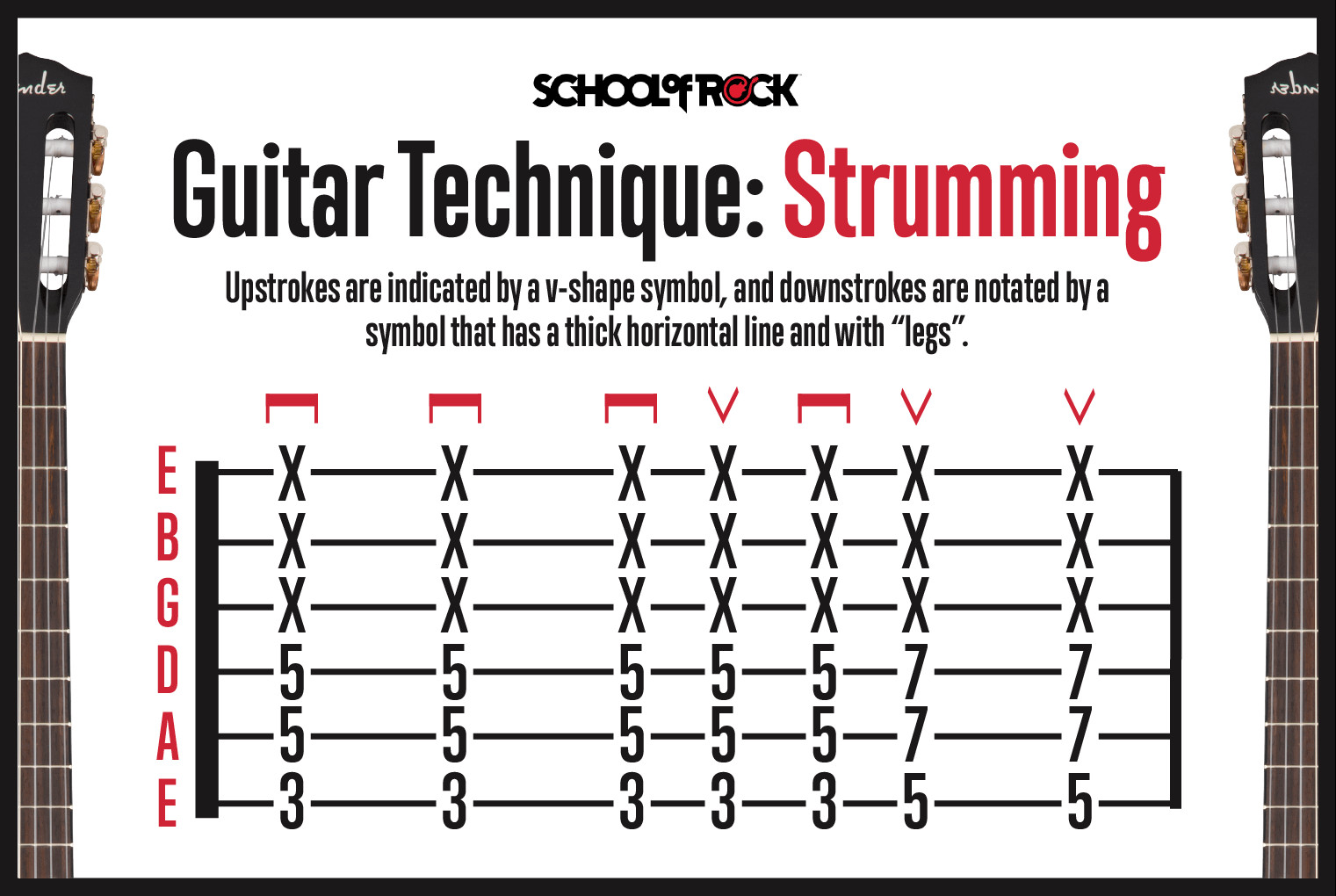 Guitar technique strumming
Guitar technique strumming
HOW TO STRUM GUITAR EFFECTIVELY
When playing chords, various strumming patterns are used depending on the song’s rhythm and style. You can use a constant down-up strumming pattern or create more complex rhythms by varying the sequence of downstrokes and upstrokes. Songs with an eighth-note rhythm are often counted as “one, and, two, and, three, and, four, and…” Many songs use alternating downstrokes and upstrokes on eighth notes, with downstrokes on the numbered beats (1, 2, 3, 4) and upstrokes on the “ands.”
GUITAR TECHNIQUE: PLAYING DOWNSTROKES AND UPSTROKES FOR SINGLE NOTES
The same downstroke and upstroke notation applies even when playing single notes in guitar tabs. A downstroke, indicated by the horizontal bar symbol, means your pick moves downwards as you play the note. Conversely, an upstroke, indicated by the “V” symbol, means your pick moves upwards.
READY TO EXPLORE MORE GUITAR TECHNIQUES?
Now that you’ve learned how to read guitar music tabs and understand many of the guitar techniques they represent, you’re well-equipped to start playing a vast range of music. From beginner basics to advanced techniques, guitarplayers.net is committed to helping you achieve your musical goals. Our resources and guides are designed to help you quickly learn your favorite songs and master the guitar.
Eager to find guitar tabs to play? From easy songs perfect for beginners to challenging pieces for experienced players, guitarplayers.net has you covered. Explore our extensive collection of guitar music tabs and start playing today!
Thinking about getting a new guitar? Check out our Guitar Buying Guide

